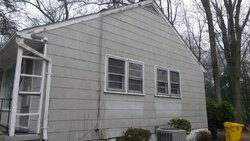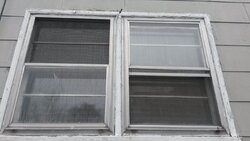So, I think you might look at a scenario that looks more like a conventional energy retrofit than a deep energy retrofit, just for comparison sake on cost/labor/ROI.
The conventional retrofit approach would be:
1) Cellulose the walls.
2) Airseal the rim/sills and attic floor (requiring pulling up the attic decking), and mucking around underneath.
3) Upinsulating the attic floor to code R-value, maintaining a generous storage area with new decking with some sheet foam underneath, and burying the rest in blown cellulose to R-50...and maintaining the attic venting, go for conventional soffit-chute-ridge if it doesn't exist now.
4) Ditch the oil heating system in favor of (assume no nat gas) a heat pump system. This could be mini-split(s), which are very DIY-able if you find an HVAC tech to do the final pump down line hookup for the cost of the time. I prefer ducted systems for comfort (and convention)...this would require running ducts, either in the attic, basement, or new ceiling soffits.
5) if DHW comes from the oil system, switch it to another source, like a HPWH (with local utility rebates).
(except for 1, this is exactly what I did to my 1960 split level over the last 6 years)
In terms of planning, 2 has to be before 3, and 1 and 2 should be before 4, but other wise order is flexible. all of 1-5 will have 2-5 year simple payback on material costs + even pricing your labor in.
Your roof/siding/window projects are all **separate** from the energy retrofit aspects, and are done as needed for leaks/durability. These projects become much simpler because architectural changes are not required. IMO, this plan would drop you heating BTU load by 50-60%, depending on current airsealing, and your heating+DHW cost by 70-80% (using cheaper BTU sources). Final structure would have energy usage comparable to proper new construction to 2011 energy codes, and half that of existing US housing stock. You would likely have the lowest energy bills on the block for many years to come.
The reason this is the conventional approach is b/c it has the best bang for the buck in terms of labor and materials.
You can try computing the delta cost/savings for each job component.
Creating a sealed, code insulated attic is nice, but a lot more expensive for materials, and requires spray foaming which IMO is not DIY. I could see the case IF you gained a living space, or at least a useable playroom for the kids. With your low 4/12 roof, I don't see that in the card. If you are replacing the roof anyway, and are a master carpenter, you could go one step further and raise the roof height and or slope/add dormers to add useable space to your home, but that would depend on a lot of factors (including adding permanent stair access from below).
Foaming the outside versus not, would reduce the final heating cost by 10%, maybe a couple hundred dollars on oil, or $100/year if switched to HP tech. Siding sounds like it is done, and will be trashed during the wall fill work. I'd look at new cement shingle or cement clapboard versus vinyl, but to each his own.
Getting rid of the oil system was technically complicated, but I feel is the best thing that I have done. I have better DHW service, no maintenance issues/costs/contracts. I have no CO worries, and the replacement, while requiring new hardware, has saved me as much if not more money than the envelope work, and resulted in a much more comfortable and clean house. Even if resale is a long way aways, I figure that fuel oil will not be popular at all 10 or 15 years from now.






 Hope this will be of help to you.
Hope this will be of help to you.